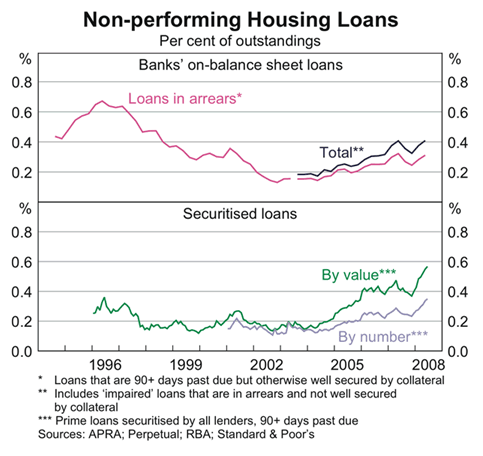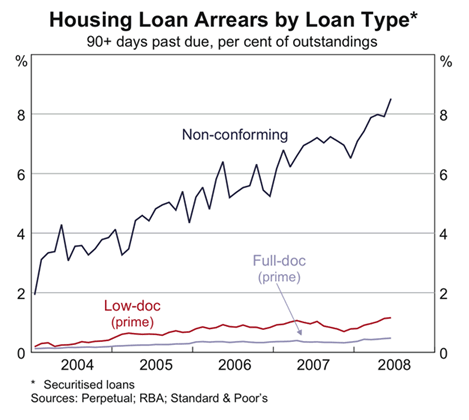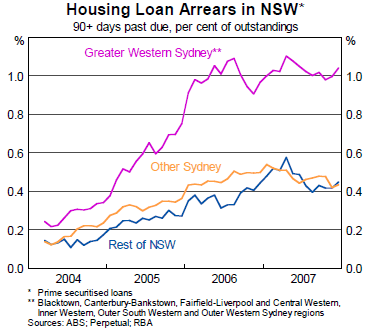
Last week, Bank of Tokyo-Mitsubishi announced the first major salvo by a Japanese bank into the Australian mortgage market, extending a $500 million one-year mortgage-backed facility to AMP Ltd.
Today, The AFR reports that US banking giants Citigroup and JP Morgan, who are flush with liquidity following the Federal Reserve’s quantitative easing operations, have become large investors in Australian residential mortgage-backed securities (RMBS), both directly and by providing “warehousing” loans while mortgages wait to be split into pools and then sold-off to investors as RMBS. There also appears to have been a rise in sub-prime RMBS issuance:
US banking giant Citigroup has been among largest investors in Australian residential mortgage-backed securities (RMBS) offers this year – and sits fourth in the local league tables with involvement in five deals. Citigroup’s buying follows heavy investment from another US banking behemoth – JPMorgan…
Unlike Australia’s banks, which have a structural shortfall of deposits, the big US banks are flush with cash. They look far and wide for safe investments to ensure their excess deposits don’t become a drag on profitability. That’s similar for Japan’s banks…
Warehouse loans and mortgage-backed securities let banks earn healthy margins of more than 1 per cent over the bank bill rate but with less effort, overheads and capital associated with originating mortgages. Securitisation has been trumpeted as a way to increase competition, but its been a handy side business for the big banks that extend short-term warehouse funding to their competitors…
Last week, two “sub-prime” RMBS offers by Bluestone, returning after a long absence from issuing RMBS, and Resimac garnered strong support from investors.
While the re-emergence of mortgage securitisation in Australia should help to boost competition in the mortgage market, it does also raise financial stability risks.
It was the rise of non-bank lenders using mortgage securitisation that caused an intensification of competition amongst mortgage lenders in the mid-1990s. With no formal regulator and no rules outside of regular trade practices and corporations law, they led the decline in Australian credit standards by introducing ‘innovative’ loan products like low-doc loans in 1997, then ‘no-doc’ loans in 1999, and more recently they were beginning to issue ‘non-conforming’ (sub-prime) loans just before the GFC intervened.
Faced with this new competitive threat, Australia’s banks responded in kind by reducing their deposit requirements and tapping new sources of funding offshore, much of it short-term. Gone were the days of requiring a minimum 20% housing deposit and restricting home loans to an amount that could be repaid with 30% of a household’s gross earnings. Instead, banks accepted 5% housing deposits and lent households an amount that, after loan repayments, left them with just enough money to ensure that they stayed above the Henderson poverty line.
The massive increase in the availability of credit arising from this increased competition, combined with unresponsive housing supply, is what fueled the explosion of housing values across Australia.
Indeed, evidence from the RBA seems to support my contention.
First, securitised non-performing housing loans (NPHL) were one-third higher than on-balance sheet loans at the height of the GFC:
Second, the securitisers were the main provider of non-conforming (sub-prime) loans, which had a delinquency rate far above the banks’ on-balance sheet housing loans:
Finally, in Western Sydney, where arrears on housing loans were far higher than those in other parts of Sydney or Australia, there was a disproportionately large share of housing loans sourced from non-bank lenders (mortgage securitisers):
According to the RBA in 2008:
…a disproportionately large share of the housing loans in this region was sourced from non-bank lenders. This may imply that a smaller proportion of the borrowers in the region met banks’ lending guidelines and/or that some of those marketing the non-bank loans arranged loans that were inappropriate for some people. The arrears rate on loans from non-bank lenders in this part of Sydney is running at three times that for loans on the major banks’ balance sheets….
In short, beware the unintended consequences of increased mortgage securitisation. Previous episodes have led to a significant loosening of credit standards and a substantial increase in the amounts that households could borrow for housing, resulting in increased debt that has been capitalised into house prices, and overall lower housing affordability.




